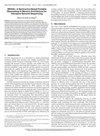RoSR: A Novel Selective Retransmission FPGA Architecture for RDMA NICs
IF 1.4
3区 计算机科学
Q4 COMPUTER SCIENCE, HARDWARE & ARCHITECTURE
引用次数: 0
Abstract
Remote Direct Memory Access (RDMA) enables low-latency datacenter networks but suffers from inefficient loss recovery using Go-Back-N (GBN). GBN retransmits entire packet windows, degrading Flow Completion Time (FCT) under congestion. We introduce RoSR, a novel selective retransmission architecture for Field-Programmable Gate Array (FPGA)-based RDMA NICs that supports hardware-accelerated direct writes of out-of-order (OoO) packets. RoSR supports efficient OoO packet reception and enables fine-grained retransmission using a dynamic shared bitmap for packet tracking. By extending the RDMA over Converged Ethernet version 2 (RoCEv2) packet format, RoSR facilitates selective retransmission. It triggers retransmissions via timeouts using bitmap blocks and introduces new Nack-bitmap and rd-req-bitmap messages for loss reporting. Under 1% packet loss, RoSR achieves up to 13.5× (RDMA Write) and 15.6× (RDMA Read) higher throughput than Xilinx ERNIC. In NS-3 simulations using the HPCC RDMA stack, RoSR reduces FCT slowdown by 3× to 6× compared to GBN across various packet loss rates, congestion control algorithms (DCQCN, HPCC, Timely), and traffic patterns, while maintaining robustness under high round-trip time (RTT) conditions.一种新的RDMA网卡选择性重传FPGA架构
远程直接内存访问(RDMA)支持低延迟的数据中心网络,但使用Go-Back-N (GBN)时存在效率低下的损失恢复问题。GBN重传整个数据包窗口,降低了拥塞下的流完成时间(FCT)。我们介绍了RoSR,一种新的选择性重传架构,用于基于现场可编程门阵列(FPGA)的RDMA网卡,支持硬件加速的乱序(OoO)数据包的直接写入。RoSR支持有效的OoO数据包接收,并使用动态共享位图实现数据包跟踪的细粒度重传。通过扩展RDMA over Converged Ethernet version 2 (RoCEv2)数据包格式,RoSR促进了选择性重传。它通过使用位图块的超时触发重传,并为丢失报告引入了新的ack-bitmap和rd-req-bitmap消息。在丢包率为1%的情况下,RoSR的吞吐量比Xilinx ERNIC高13.5倍(RDMA Write)和15.6倍(RDMA Read)。在使用HPCC RDMA堆栈的NS-3模拟中,与GBN相比,RoSR在各种丢包率、拥塞控制算法(DCQCN、HPCC、Timely)和流量模式下将FCT减速减少了3到6倍,同时在高往返时间(RTT)条件下保持鲁棒性。
本文章由计算机程序翻译,如有差异,请以英文原文为准。
求助全文
约1分钟内获得全文
求助全文
来源期刊

IEEE Computer Architecture Letters
COMPUTER SCIENCE, HARDWARE & ARCHITECTURE-
CiteScore
4.60
自引率
4.30%
发文量
29
期刊介绍:
IEEE Computer Architecture Letters is a rigorously peer-reviewed forum for publishing early, high-impact results in the areas of uni- and multiprocessor computer systems, computer architecture, microarchitecture, workload characterization, performance evaluation and simulation techniques, and power-aware computing. Submissions are welcomed on any topic in computer architecture, especially but not limited to: microprocessor and multiprocessor systems, microarchitecture and ILP processors, workload characterization, performance evaluation and simulation techniques, compiler-hardware and operating system-hardware interactions, interconnect architectures, memory and cache systems, power and thermal issues at the architecture level, I/O architectures and techniques, independent validation of previously published results, analysis of unsuccessful techniques, domain-specific processor architectures (e.g., embedded, graphics, network, etc.), real-time and high-availability architectures, reconfigurable systems.
 求助内容:
求助内容: 应助结果提醒方式:
应助结果提醒方式:


